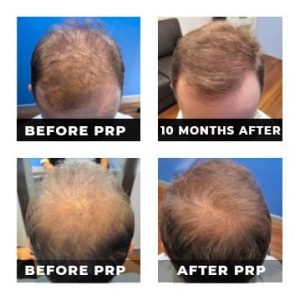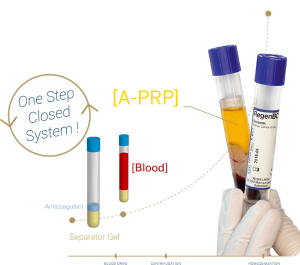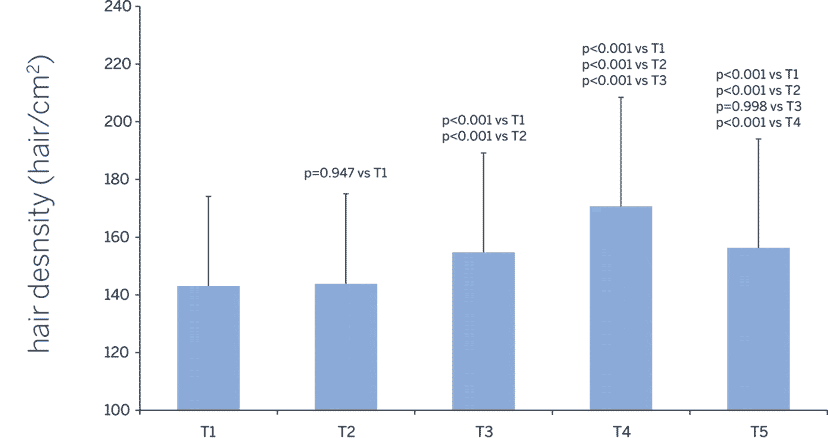
What is Growth Cell Therapy Treatment?
- Growth Cell Therapy is obtained from the patients own blood and consists essentially of platelets and other blood components such as plasma, vitamins and minerals.
- Platelets are responsible for healing and contain active molecules called growth factors, which allow for the natural healing of damaged tissues.
- Growth Cell Therapy involves concentrating the platelets found in the blood sample.
- A normal concentration of platelets circulating in your blood is 200,000 per microlitre, the platelet count in Growth Cell Therapy can exceed 1 million platelets per microlitre.
- Growth Cell Therapy is the only available product that contains elevated levels of naturally occurring growth factors that help stimulate hair follicles making it extremely useful for men and women’s hair restoration programs.
- The primary purpose of using Growth Cell Therapy in hair restoration is to stimulate inactive or newly implanted hair follicles into an active growth phase.
Growth Cell Therapy preliminary studies indicate patients respond to Growth Cell Therapy therapy well. Larger clinical studies are pending but the current medical literature contains numerous optimistic results. Growth Cell Therapy as a non-surgical option offers patients with miniaturization and hair thinning improvement in hair calibre and thickness, of course, individual results vary with each patient.
Advantages of Growth Cell Therapy
- Naturally stimulates hair growth
- Increases hair volume, density and fullness
- Increases survival and strengthening of existing hair
- Improves hair quality
- Decreases hair loss
- Overall high patient satisfaction
- The only non-surgical and non-pharmaceutical treatment that has proven its efficacy
- Can be used in conjunction with other therapies and medications for hair loss

The Science of Growth Cell Therapy
The concentrated platelets found in Growth Cell Therapy can theoretically cause the growth of the hair follicles by stimulating the stem cells and other cells in the microenvironment of the hair follicle. Inside the Platelets are many intracellular structures such as glycogen, lysosomes and alpha granules. These granules within the Growth Cell Therapy contain clotting and growth factors that are eventually released during the healing and repair process.
What Does the Treatment Entail?
The Growth Cell Therapy treatment takes about 60 minutes and is performed on an outpatient basis.
- A blood sample (8-25ml) is collected in a similar way to a blood test
- Centrifugation and separation of blood constituents
- Ready-to-use Growth Cell Therapy is recovered into a syringe
- Ready-to-use Growth Cell Therapy can now be re-injected into the scalp (subdermal 1.5-2.5mm).
- LLL therapy is given
What type of Alopecia can be treated?
- Androgenic Alopecia: a major form of hair loss, mainly due to hormonal disturbances;
- Diffuse Alopecia: caused by a physiological change such as stress, nutrient deficiencies, etc;
- Alopecia Areata: autoimmune disease in which hair is lost from some or all areas of the scalp

Norwood Scale
How many sessions are needed?
Advanced Hair Clinic has studied current research for optimal treatment regimes for hair restoration. Results showed that a significant increase in the rate of hair growth was observed between the 3rd and 6th months. Hair density followed a rising trend with a remarkable peak at 3 months. Patients with II-III grade of alopecia had better results compared to patients with more advanced alopecia
- Initial Growth Cell Therapy at weeks 0, 3, 6 and 12
- Booster Growth Cell Therapy at 6 and 12 months from the start of treatment
- Maintenance treatments bi-annually (dependent on the outcome)
- Low-level laser to be used in conjunction with Growth Cell Therapy to enhance platelet activation.

The Growth Cell Therapy Treatment
- Initial consultation to determine areas of hair loss to be treated, medical history, photographic record and pre-procedure instructions and tips.
- Day of the procedure –
- The scalp is prepared with an antiseptic solution
- A topical analgesic cream is placed on the area to be treated to numb the scalp
- Blood is taken from the patient and centrifuged in preparation for injection
- Small injections of the Growth Cell Therapy deliver the platelet-derived growth factors into the skin at the level of the weak follicles. Micro-needling is performed.
- A session of Low-Level Laser Therapy is performed before the patient leaves the office.
Is there a Recovery Period or Downtime after Growth Cell Therapy Treatments?
- There is no activity restriction after a Growth Cell Therapy treatment.
- Patients may shower/shampoo/condition their hair normally just several hours after the treatment and resume normal daily and athletic activities.
- Some brief mild inflammation noticeable as redness/pinkness and numbness of the scalp may be present for several hours.
- No harsh chemical colouring or perming treatments should be performed for at least 72 hours.
- Use of topical hair growth treatments like Minoxidil or similar can resume the next day.
Are there any factors that would make someone ineligible for Growth Cell Therapy?
- The vast majority of healthy individuals can easily undergo Growth Cell Therapy treatments.
- Certain conditions like blood and platelet disorders, chronic liver disease, the presence of an active severe infection, cardiovascular or hemodynamic instability and/or anticoagulation therapy are contraindicated.
- Different areas of the scalp may respond differently to Growth Cell Therapy depending on the number of weak hair follicles present in each zone. Generally, with the exception of small round areas of alopecia areata, locations, where severe depletion of follicles has occurred, should not be treated.
To find out more about the cause of your hair loss and the available treatments, contact Advanced Hair Studio today for a Advanced Hair Check.